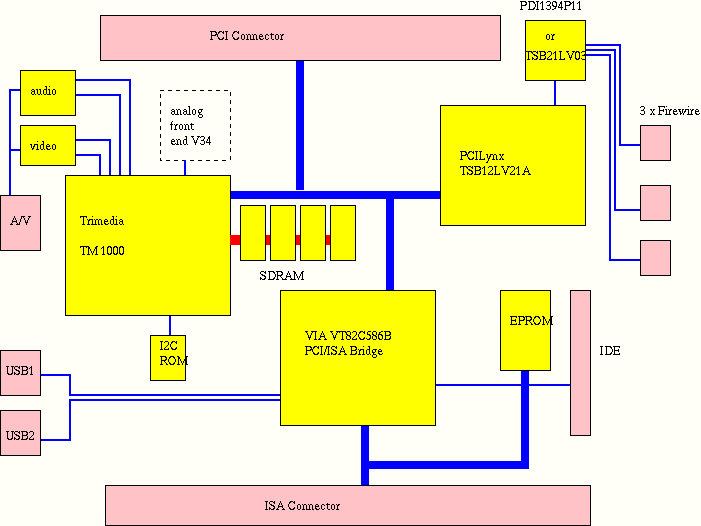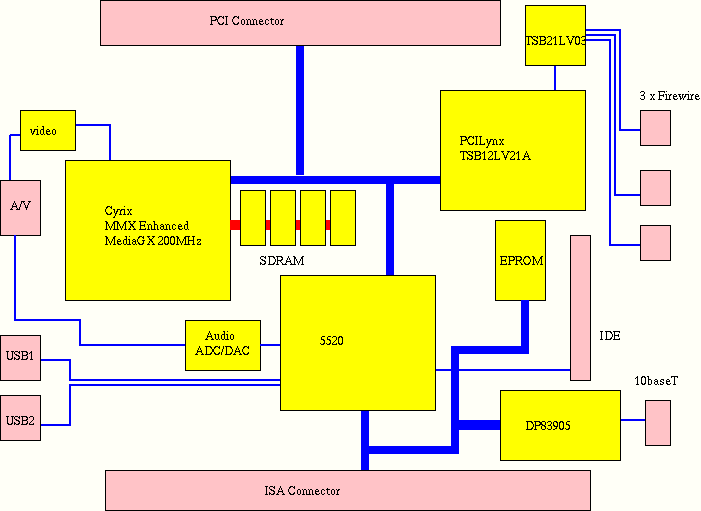
The Merlin OO OS will run on regular PCs, so it makes no sense to build custom hardware unless it complements PCs. Just as the first four Merlin designs, starting in 1985, were destined to fill the Network Computer role that traditional PCs weren't very good at (but this niche is finally being filled by several products in 1997) so will Merlin 5 allow us to build things such as digital set top boxes, home banking terminals, virtual and augmented reality portable machines, and so on. None of these applications would be very practical to build around a traditional Intel PC (though some people try) nor with traditional operating systems.
In 1985 a strict policy was adopted for Merlin hardware - no component could be used in a design unless it was already used in some other product that was shipping in volume. This is why the Merlin III was based on the 68020 instead of the ARM, for example. Since the core of Merlin 5, the Philips Trimedia, still doesn't meet this restriction, the prototype is being delayed from December 1997 to sometime around February 1998.
The hardware was designed with flexibility in mind, so a wide range of applications are possible. Those listed below are just the most obvious possibilities. Some applications for which this design is not particularly well suited are traditional desktop computers. It might make an interesting Network Computer, however, even if it was not targeted for this as all previous Merlin hardware designs were.
Not all features will be needed in all applications. The cheapest solution will be to simply omit any unneeded component leaving that part of the printed circuit board blank. The cost might be slightly lower if the PCB is redesigned to eliminate that part of the circuit entirely, but it normally won't be worth it.
Having just recently entered the world of Cable TV, Brazil has the advantage of starting out with "fiber to the curb". This makes the transition to digital TV an even more compelling proposition than in more mature markets which will first have to significantly overhaul their infrastructure. LSI-USP is working with a major international company to develop the interactive services that this new communication system will make possible and Merlin 5 will make an excellent "set top box". A PC/104+ cable modem will have to be developed for this application, though for the prototyping phase connecting an external one through a standard Ethernet board should be sufficient. The whole Firewire part of the machine may be eliminated to lower costs.
A key software development that will make interactive digital services attractive will be the adoption of the MPEG4 set of standards. MPEG1 made video in CD-ROM applications practical while MPEG2 has brought us digital satellite broadcasting and DVD players. MPEG4 will be geared to two way information flow and the integration of natural and synthetic images and sounds. "Viewers" will be transformed into "buyers", "players", "chat partners" and so on. A solid, distributed operating system like Merlin will make a great difference when developing these kinds of applications.
While the bandwidth that will be available with cable modems is truly impressive, most people will have to live with the limitations of plain old telephone lines (POTS) for quite some time yet. This is no reason for them not to have access to a wide range of services, such as home banking, video conferencing, internet access and so on.
A normal PC and a modem could be used for this application, but a dedicated terminal can reach a wider audience. The Graphics Group at LSI-USP is developing such an equipment for a joint venture between an international company and a local one with a strong presence in the financial market. Like in the previous application, the Firewire interface may be retained to maximize upgradability or eliminated to reduce costs. Only a small analog front end needs to be installed to have a built-in modem using the DSP capabilities of the Trimedia. The built-in video input makes video conferencing a compelling application for this design.
Personal Computers have done a great job of bringing computing power to the masses, but a less than stellar job of being "personal". Many applications are not possible if the machine is simply not available, either because it is somewhere else (a desktop computer back at the office) or because it will take too long to turn on, boot and invoke the application. Personal Digital Assistants (PDAs) come much closer to solving the problem, but they are still a bother to carry around and use. Wearable computers are the best solution as they can become an integral part of people's lives, just like wristwatches are today.
Unlike virtual reality, which seeks to isolate the user in an artificial world, augmented reality aims to add useful computer generated information to the user's natural environment. Some examples might include being able to scroll through a shopping list while looking through the shelves in a local supermarket or checking detailed schematics while opening some equipment. Moving information from the real world to the computer is equally useful - to be able to scan in a drawing a teacher made on the blackboard or save the image of people saying their names could really help complement our memories.
Like any portable machine, the issues of weight and battery life are critical in this design. The Trimedia can consume a peak of 4W, though its flexible power management features can greatly limit this. A more critical and complex element in this application is the design of the "head set". This piece connects to the A/V port and includes stereo headphones, a miniature LCD "virtual screen", a microphone and a tiny video camera. It should fold neatly when the screen is not in use, yet provide a steady image when deployed. Though the USB ports allow keyboards and pointing devices to be added as needed, the main mode of text entry is expected to be voice recognition while the mouse will be replaced by gesture recognition with the video camera. Video input will also be extensively used in scanning in materials and also in detecting head movement to synchronize information overlays with the external environment.
The block diagram shows the main components of the Merlin 5. There is actually little else besides this due to the high level of integration of modern ICs. The only major complication is the large number of different clocks required by this design, which is not shown in the diagram. This will have to be handled carefully to avoid filling the board with crystals. It is interesting to note how the mechanical design is dominated by the connectors (in pink) rather than the components (in yellow).

Trimedia
The Philips Trimedia TM-1000 processor is a low cost, highly integrated multimedia CPU. The key features of TM1000 are:
PC/104+
For the proposed applications, low cost and small size are the most important factors. The PC/104+ standard meets these requirements. While totally compatible with standard ISA/PCI computers at the electrical level, it is composed mechanically of stackable boards only 3.5 by 3.8 inches in size. While PC/104+ boards are much harder to find than their normal PCI or ISA counterparts, there is currently sufficient variety to enable most applications.
FireWire
The IEEE1394 high performance serial bus is already used in digital video cameras and will quickly become an interesting alternative to SCSI in 1998. This plug and play connection allows data to flow at rates up to 400Mbps, including special isosynchronous channels for time-critical data like sound and video. Adding storage and special disks (DVD, for example) is now just a matter of hooking up a cable, not taking the machine apart and rebuilding it.
USB
Keyboards, mice, digital speakers and other low bandwidth peripherals are starting to adopt the Universal Serial Bus (USB) standard. While it sound similar to Firewire, it actually complements it due its extremely low cost. A Firewire joystick, for example, would make no sense.
A/V Port
The Trimedia can handle video output and input, as well as sound output and input. The video output must be available in analog RGB, SVHS and composite formats. It wouldn't be possible to fit all of the needed connectors on such a tiny board, so a single combo connector encompasses all audio and video input and output. A series of special "break-out cables" can be used for different applications. Where a little more space is available, a connector panel can replace the combo connector.
V34 serial port
A modern modem includes a digital signal processor and an analog front end. The Trimedia is much more powerful than the typical modem DSP and includes a serial port that can connect to an analog front end to make either an integrated V34 standard modem or an ISDN port. This not only reduces costs, but also gives software much more control over low speed communication functions.
Boot ROM/IDE
The Trimedia actually boots from a small I2C standard EEPROM. This is only 4KB in size, however, so a larger device is needed to hold the OS. Either a 4MB Flash memory can be used where Firewire disks are present or low power and weight are absolutely essential or an IDE hard disk can hold system software and provide some local storage.
And this is the block diagram for an alternative design:

Note how similar this is to the first one. It doesn't have a video input (but that doesn't have to be much of a problem if a USB or FireWire camera is used) and the CPU isn't quite as fast as the Trimedia. This is specially true for video applications - the MediaGX can only do MPEG-1 video in software while the Trimedia's coprocessors allow it to handle MPEG-2 with power to spare.
On the other hand, this is compatible with a wide range of IBM PC operating systems and applications, so it is useful independently of the Merlin project. And these chips are already being used in shipping products.